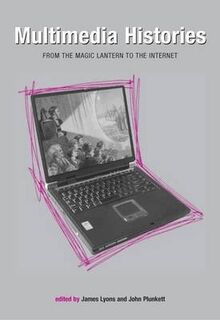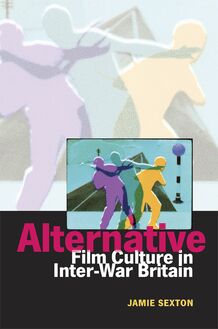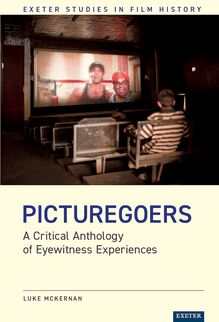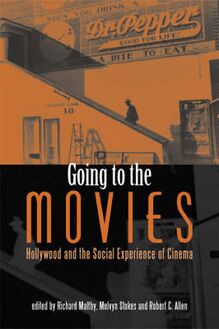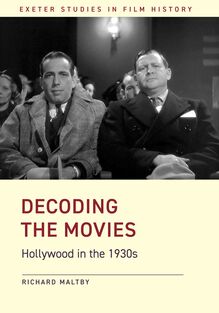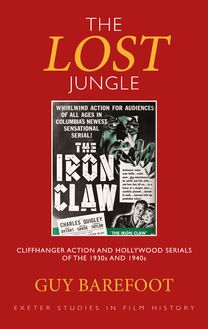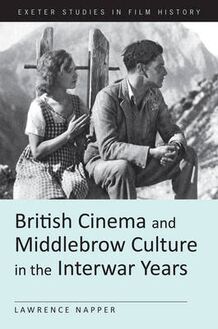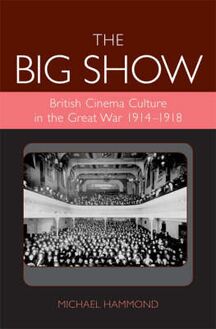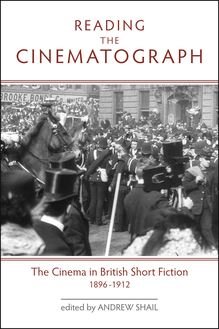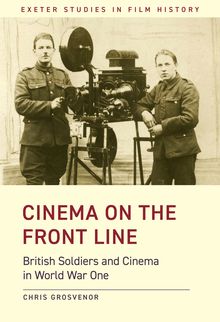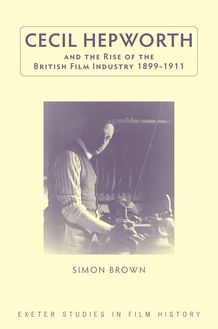-
 Univers
Univers
-
 Ebooks
Ebooks
-
 Livres audio
Livres audio
-
 Presse
Presse
-
 Podcasts
Podcasts
-
 BD
BD
-
 Documents
Documents
-
- Cours
- Révisions
- Ressources pédagogiques
- Sciences de l’éducation
- Manuels scolaires
- Langues
- Travaux de classe
- Annales de BEP
- Etudes supérieures
- Maternelle et primaire
- Fiches de lecture
- Orientation scolaire
- Méthodologie
- Corrigés de devoir
- Annales d’examens et concours
- Annales du bac
- Annales du brevet
- Rapports de stage
La lecture à portée de main
Vous pourrez modifier la taille du texte de cet ouvrage
Découvre YouScribe en t'inscrivant gratuitement
Je m'inscrisDécouvre YouScribe en t'inscrivant gratuitement
Je m'inscrisEn savoir plus
Vous pourrez modifier la taille du texte de cet ouvrage
En savoir plus

Description
Winner of the Theatre Library Association’s 2021 Richard Wall Memorial Award for an exemplary work in the field of recorded performance.
Cinema on the Front Line offers the first comprehensive history and analysis of how the medium of cinema intersected with the lives of British soldiers during the First World War. Documenting the wartime use of cinema, from domestic recruitment drives to makeshift theatrical venues established on the front line, and then in convalescent hospitals and camps, this book provides evidence of the previously unacknowledged importance of the medium as recreational support and entertainment for soldiers living through the trauma of conflict.
Presenting the fruits of his archival research, the author makes extensive use of war diaries and other military records to foreground the voices and perspectives of British soldiers themselves. Including discussion of over 70 films, this book will interest specialists in British film history, propaganda film, exhibition and audience studies, as well as historians and students of the First World War, propaganda and the military.
DOI: https://doi.org/10.47788/LAML7430
List of Illustrations
Acknowledgements
Introduction
Chapter 1: Cinema, Recruitment Campaigns and the Outbreak of War
Chapter 2: The BEF and Film Exhibition on the Western Front
Chapter 3: Soldier Cinema Audiences on the Front Line
Chapter 4: A War of Representation: Soldiers and Topical Films
Chapter 5: The Cinema, Recovery and Rehabilitation
Afterword
Appendix
Bibliography
Index
Sujets
Informations
| Publié par | University of Exeter Press |
| Date de parution | 29 octobre 2021 |
| Nombre de lectures | 0 |
| EAN13 | 9781905816743 |
| Langue | English |
| Poids de l'ouvrage | 2 Mo |
Informations légales : prix de location à la page 0,5300€. Cette information est donnée uniquement à titre indicatif conformément à la législation en vigueur.
Extrait
Cinema on the Front Line
Exeter Studies in Film History
Series Editors:
Richard Maltby , Matthew Flinders Distinguished Emeritus Professor of Screen Studies, Flinders University
Helen Hanson , Associate Professor in Film History at the University of Exeter and Academic Director of the Bill Douglas Cinema Museum
Joe Kember , Professor in Film Studies at the University of Exeter
Exeter Studies in Film History is devoted to publishing the best new scholarship on the cultural, technical and aesthetic history of cinema. The aims of the series are to reconsider established orthodoxies and to revise our understanding of cinema’s past by shedding light on neglected areas in film history.
Published by University of Exeter Press in association with the Bill Douglas Centre for the History of Cinema and Popular Culture, the series includes monographs and essay collections, translations of major works written in other languages, and reprinted editions of important texts in cinema history.
Previously published titles in the series are listed at the back of this volume
Cinema on the Front Line
British Soldiers and Cinema in the First World War
CHRIS GROSVENOR
First published in 2021 by
University of Exeter Press
Reed Hall, Streatham Drive
Exeter EX4 4QR
UK
www.exeterpress.co.uk
© Chris Grosvenor 2021
All rights reserved.
The right of Chris Grosvenor to be identified as author of this work has been asserted by him in accordance with the Copyright, Designs and Patents Act 1988.
Exeter Studies in Film History
British Library Cataloguing in Publication Data:
A catalogue record for this book is available
from the British Library.
Hbk ISBN 978-1-905816-73-6
ePub ISBN 978-1-905816-74-3
PDF ISBN 978-1-905816-75-0
https://doi.org/10.47788/LAML7430
An earlier version of Chapter 4 was originally published as ‘“He Sees Now What He Looked Like”: Soldier Spectators, Topical Films, and the Problem of Onscreen Representation during World War I’, Film History: An International Journal , vol. 30, no. 4 (2018): 84–106.
An earlier version of Chapter 5 was originally published as ‘“Dr Kinema”: The Cinema, The Trade and the Rehabilitation of Wounded and Disabled Soldiers During the First World War’, Historical Journal of Film, Radio and Television , vol. 40, no. 1 (2020): 140–61.
Cover image: Two British soldiers standing beside a projector, c. 1915.
Courtesy of the Bill Douglas Cinema Museum, University of Exeter.
For Mum and Dad
Contents
List of Illustrations
Acknowledgements
Introduction
Chapter 1: Cinema, Recruitment Campaigns and the Outbreak of War
Chapter 2: The BEF and Film Exhibition on the Western Front
Chapter 3: Soldier Cinema Audiences on the Front Line
Chapter 4: A War of Representation: Soldiers and Topical Films
Chapter 5: The Cinema, Recovery and Rehabilitation
Afterword
Appendix
Notes
Bibliography
Filmography
Index
Illustrations
0.1 Postcard depicting a column of British soldiers marching past a cinema, c. 1916.
1.1 Soldiers in formation in Topical Budget’s Citizen Army Inspected , 1915.
1.2 Civilians walk into a recruiting office in Recruiting for the 5th Essex , 1915.
1.3 A group of marching soldiers in the Topical Budget’s On the March , 1915.
1.4 A disguised ‘shirker’ is unmasked in the one-reel Aylott comedy Conscription , 1915.
1.5 Promotional postcard for Wake Up! , 1914.
2.1 British soldiers posing for the camera outside a ‘British Cinema’ in occupied Germany, c .1919.
2.2 Enlargement of 4th Division Routine Order, dated 4 February 1915.
2.3 Postcard showing a cinema housed in a dilapidated building, c .1916.
2.4 Still from the film German Offensive , produced by the Topical Film Company in 1918, showing a war-damaged cinema somewhere on the Western Front.
2.5 The staff of the 92nd Motor Transport Company Cinema, c. 1919.
2.6 Two British soldiers standing beside a projector (most likely a Pathé 1913 model), c. 1916.
2.7 The Cavalry Division cinema’s portable dynamo, c. 1918.
3.1 ‘Patrons’ illustration from Pictures and the Picturegoer , 22 May 1915.
3.2 A Chaplin impersonator on the front line.
3.3 Postcard titled ‘Watch Him Jump’, c. 1916.
3.4 Untitled illustration from Poison Gas – unofficial organ of the 3rd Battalion Queen Victoria’s Rifles, 1 February 1916.
3.5 ‘Dranoutre Electric Palace’ from the Kemmel Times , 3 July 1916.
4.1 Frame from The Leopard’s Spots (Hepworth, 1918) depicting a staged sequence in which two German soldiers harass a French woman before killing her child.
4.2 ‘Home on Leave’ illustration by J. Thomson, The Outpost , 1 February 1918.
4.3 ‘Out of the frying pan’ illustration, Pictures and the Picturegoer , 20 April 1918.
4.4 Frame from the ‘over-the-top’ sequence of The Battle of the Somme (Malins and McDowell, 1916), generally acknowledged to have been faked for the camera.
5.1 ‘Ceiling Cinema’, Illustrated London News , 10 August 1918.
5.2 ‘To Wounded Soldiers and Sailors!’ advertisement for the West End Cinema, The Buzz: The Organ of the Bizzie Bees , 1 December 1917.
5.3 ‘The Trade’s “Little Bit”’, The Kinematograph Year Book 1917 .
5.4 Two wounded soldiers hold up a young girl in Wounded at Kew , 1915.
6.1 ‘How the Good News came to Harefield’ photo, c. 11 November 1918.
Table 1: British military formations with cinemas on the Western Front, 1914–1918.
Table 2: Films screened by 4 Corps cinema, 15 January–18 March 1918.
Acknowledgements
This book originated in my PhD thesis and so, first and foremost, I want to thank all of the academics who have supported me throughout my PhD research and beyond. Joe Kember, Debra Ramsay, Lisa Stead and Jon Burrows have offered invaluable guidance and feedback on the project from genesis to publication, without which this book would have been impossible to produce. I also wish to thank Phil Wickham of the Bill Douglas Cinema Museum for his continued support of the project, inviting me to discuss my research at various museum-related events over the years, allowing me free rein within the museum’s collection for research, and for the use of an image from the museum’s collection for this book’s cover.
For their invaluable information, suggestions for further reading/research and general encouragement, I would also like to thank Linda Williams, Michael Hammond, Nicholas Hiley, Lawrence Napper, Ellen Cheshire, Martin Baker, Guy Barefoot, Rebecca Harrison and Malcolm Cook, all of whom (even those I have only met briefly) have had only the kindest words of support and encouragement to offer. Equal thanks must also be given to the staff and archivists of the BFI Special Collections, the Imperial War Museum and the Special Collections Library at the University of Leeds, who have all kindly assisted me throughout the research process.
Finally, I would like to thank my parents, Stephen and Sue Grosvenor, for their continued love, support and encouragement, without whom I would never have been able to get this far. Oh, and Gibson of course! Finally, my thanks to Hannah Littler, who continues to offer love, friendship and guidance, and who, I am certain, has listened to me ramble on about Charlie Chaplin and ‘war diaries’ for far longer than any partner has the right to do. For this, I will be forever grateful.
Introduction
In early 1916, over a year after the declaration of war on 4 August 1914, a photo ( Fig. 0.1 ) was taken of a column of British soldiers marching past a civilian cinema. At first, the image appears jarring, perhaps even alarming. A city scene has been invaded by a column of men cutting through a once peaceful civilian setting. In the background, the tension between military order and civilian day-to-day life is epitomized through the contrasting presence of a local cinema screening Charles Weston’s A Woman without a Soul (1915). The cinema—a site of comfort, relaxation and amusement—seems to juxtapose the immediate circumstances of the outside world: a continent at war, a generation of young men marching off to fight and perhaps die for their country, their families anxiously awaiting the latest war news at home. In times of war, the cinema and other forms of entertainment are often thought of as frivolous and distracting, unsuitable for the seriousness of the circumstances at hand. Such an image reinforces this sentiment, with the soldiers marching solemnly past the cinema, a few men making eye contact with the photographer, the vast majority bearing a stern and serious expression. Once men had enlisted in the British Expeditionary Force (hereafter BEF) upon the outbreak of the conflict or in the months or years after its declaration, many may be inclined to believe that they simply left behind the civilian entertainment of the cinema, turning to other forms of entertainment or recreation—sport, music, reading and writing—to fill their time on the front line instead.
0.1 Postcard depicting a column of British soldiers marching past a cinema, c. 1916. (Author’s collection)
The notion that soldiers remained absent from cinema audiences and disengaged from film culture for the duration of their active service is, in fact, incorrect. As this book will demonstrate, the cinema intersected with the lives of British soldiers at nearly every point of their military career, from their initial motivation to enlist following a patriotic recruitment campaign orchestrated by their local cinema’s proprietor, to the provision of cinematic entertainment endorsed and implemented by over fifty different formations of the BEF on the Western Front. Wounded soldiers also returned home to discover that, once again, cinemas were utilized within the context of recovery and rehabilitation for soldiers in hospitals and convalescent camps across the country. Indeed, soldiers (or potential soldiers) engaged with and were engaged by the medium of cinema in a variety of ways throughout the First World War. Distinct from the civilian audiences
-
 Univers
Univers
-
 Ebooks
Ebooks
-
 Livres audio
Livres audio
-
 Presse
Presse
-
 Podcasts
Podcasts
-
 BD
BD
-
 Documents
Documents
-
Jeunesse
-
Littérature
-
Ressources professionnelles
-
Santé et bien-être
-
Savoirs
-
Education
-
Loisirs et hobbies
-
Art, musique et cinéma
-
Actualité et débat de société
-
Jeunesse
-
Littérature
-
Ressources professionnelles
-
Santé et bien-être
-
Savoirs
-
Education
-
Loisirs et hobbies
-
Art, musique et cinéma
-
Actualité et débat de société
-
Actualités
-
Lifestyle
-
Presse jeunesse
-
Presse professionnelle
-
Pratique
-
Presse sportive
-
Presse internationale
-
Culture & Médias
-
Action et Aventures
-
Science-fiction et Fantasy
-
Société
-
Jeunesse
-
Littérature
-
Ressources professionnelles
-
Santé et bien-être
-
Savoirs
-
Education
-
Loisirs et hobbies
-
Art, musique et cinéma
-
Actualité et débat de société
- Cours
- Révisions
- Ressources pédagogiques
- Sciences de l’éducation
- Manuels scolaires
- Langues
- Travaux de classe
- Annales de BEP
- Etudes supérieures
- Maternelle et primaire
- Fiches de lecture
- Orientation scolaire
- Méthodologie
- Corrigés de devoir
- Annales d’examens et concours
- Annales du bac
- Annales du brevet
- Rapports de stage
